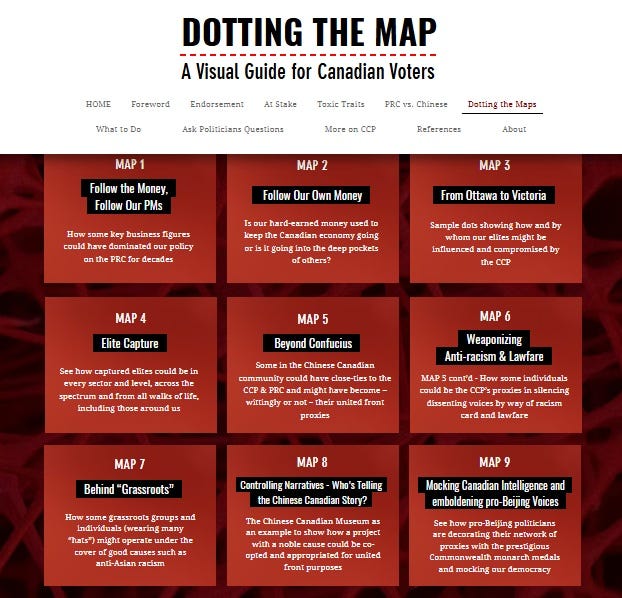FiT and CFHK Teamed Up to Launch a Visual Guide to Help Canadian Voters Confront PRC Interference
9 Maps, 1 Goal, and a Critical Election
Found in Translation (FiT) and Canadian Friends of Hong Kong (CFHK) have teamed up to produce Dotting the Map, a public interest research and civic education project that visually outlines the networks, tactics, and narratives behind the People’s Republic of China’s (PRC) influence and infiltration operations in Canada.
CFHK and FiT, two grassroots organizations founded by Canadian citizens of both Hong Kong and mainland Chinese origin, launched this joint project with the aim of helping the public ask better questions, demand greater transparency, and defend Canadian democracy from PRC interference — including, but not limited to, interference during the ongoing federal election.
Dotting the Map
At the heart of the visual guide is a series of nine thematic maps, each focusing on a key dimension of the PRC’s influence activities in Canada:
In addition to the maps, the project includes:
A list of sample questions voters can ask candidates during an election, and of politicians after they are elected
The Four Toxic Traits (4Cs) of United Front work — covert, co-opt, corrupt and coercive
Guidance on distinguishing between the PRC and the Canadian Chinese community
Actionable suggestions for voters on how to resist foreign interference
Curated lists of authoritative sources, with links and documents to support the people, institutions, events, and connections mentioned in the maps
Where to Find the Maps
The full visual guide is available on both the CFHK website and the FiT Substack.
As of April 7, 2025, all project documents have been uploaded to the CFHK website, which will continue to be updated based on community feedback.
The FiT Substack, a blog-style online publication, has added a 'Dotting the Map' button to its navigation bar; clicking this button redirects to the full project page hosted at canfriendshk.ca. In the meantime, FiT strives to publish periodic posts related to 'Dotting the Map,' including map breakdowns, election analysis, and investigative reporting based on the information revealed in the maps.
How to Use the Maps
The Dotting the Map project represents months of collaborative investigation and production by the FiT–CFHK team. Each of the nine maps contains a dense volume of information — truly, a map is worth 10,000 words. The team encourages readers to treat them not as static infographics, but as living tools for understanding PRC’s influence mechanism in Canada.
One practical suggestion is to print out the maps and post them on a wall for frequent reference. The digital versions are also searchable PDFs — making it easy to look up keywords and quickly find relevant information, especially when making decisions related to voting.
Each map uses a set of visual conventions to convey meaning. Entities — whether individuals or organizations — are placed within colored shapes such as squares, rectangles, circles, etc. The name of the entity typically appears at the top of the shape, while brief background information is shown below. In general, the larger the shape, the more influential the entity. Those depicted with profile images are considered to have greater prominence or influence than those without. Relationships between entities are illustrated with connecting arrows, and the text on each arrow explains the nature of the connection.
For deeper insight into the people, organizations, and connections illustrated in the maps — and to verify sources — readers can visit the References section of the CFHK website: https://www.canfriendshk.ca/reference. This section includes nine documents corresponding to the nine maps, with detailed, open-source citations. Sources include both English and Chinese media, official Chinese government websites, business and legal intelligence platforms, and more.
A small portion of sources has been withheld by the FiT–CFHK team for various reasons and is not listed in the reference documents. Media outlets interested in those sources may contact the team directly via email.
While most of the information presented in the maps has already been reported in public media — in English or Chinese — a small fraction was uncovered independently by the FiT–CFHK Joint Team and has never before been published. The team plans to expand on these findings in future longform reports in the coming weeks, months, and even years.
For investigative journalists and researchers, the maps may serve as a hidden goldmine of leads — potentially revealing explosive stories or crucial threads for ongoing investigations. Rather than keeping this information to themselves, the Joint Team chose to present it to the public because they believe in the public’s right to know.
To make better-informed decisions on how to counter CCP interference — during the election and beyond — Canadians are encouraged to use not only the maps, but also the accompanying materials in this project, including “The Four Toxic Traits (4Cs),” “PRC vs. Chinese,” “Ask Politicians Questions,” and more.
As members of FiT choose to remain anonymous, they are not available for media interviews. Media inquiries should be directed to CFHK at canfriendshk@gmail.com.





Great work!
Thank you.
Great work.